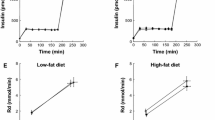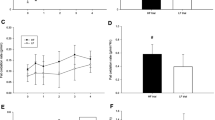Summary
Animal and human studies show that polyunsaturated fatty acids (P) are oxidized more rapidly than saturated fatty acids (S). There are indications that diets high in P/S ratio result in a relatively high resting metabolic rate (RMR) and high diet induced thermogenesis (DIT). However, studies with human subjects are limited.
The effect of dietary fatty acid composition on energy metabolism was studied in 6 male subjects, age 25–48 y. Two diets were supplied, each over a period of 14 days, in a randomized crossover design with a washout period of 14 days. P/S ratios of the diets were 0.19 and 1.67.
On day 14, RMR was determined in the morning in fasting state by means of indirect calorimetry (ventilated hood), followed by a 4 hour measurement of the DIT after consumption of a standardized meal of 3.3 MJ with the same fatty acid composition as during the dietary period. The meal contained 46, 37, and 17 % energy as fat, carbohydrate, and protein, respectively.
RMR after the period with the high P/S diet was significantly higher than after the period of the low P/S diet. The average difference (±SD) was 0.17 ± 0.14 kJ/min or 3.6±2.7 % of RMR.
The DIT was also higher in all subjects during a breakfast with a high P/S ratio. The average difference was 0.29 ± 0.16 kJ/min, which is 22.1±12.6 % of DIT.
The study showed that a prolonged food intake of a diet with a high P/S ratio results in a relatively high RMR and DIT. These results indicate the importance of dietary lipid profile in the treatment of obesity.
Zusammenfassung
Untersuchungen an Tieren und am Menschen zeigen, daß polyungesättigate Fettsäuren (P) schneller als gesättigte Fettsäuren (S) oxidiert werden. Es gibt Hinweise dafür, daß Diäten mit einem hohen P/S-Verhältnis einen relativ hohen Ruheenergieumsatz (RMR) und eine hohe diät-induzierte Thermogenese (DIT) verursachen. Untersuchungen beim Menschen sind jedoch begrenzt. Die Effekte der Nahrungsfettsäuren-Zusammensetzung auf den Energieumsatz wurden bei 6 männlichen Personen (Alter 25–48 Jahre) untersucht. In einer randomisierten Crossover-Studie wurden 2 Diäten über eine Zeitperiode von 14 Tagen mit einer anschließenden washout-Periode verabreicht. Das P/S-Verhältnis betrug bei diesen Diäten 0,19 und 1,67. RMR wurde am 14. Tag früh im Nüchternzustand mittels indirekter Kalorimetrie (ventilierte Haube) bestimmt. Daran schloß sich nach Aufnahme einer standardisierten Mahlzeit mit einem Energiegehalt von 3,3 MJ (gleiche Fettsäuren-Zusammensetzung wie während der Diätperiode) eine 4h-Messung der DIT an. Die Mahlzeit enthielt 46, 37 und 17 Energie% an Fett, Kohlenhydrate und Protein. RMR war nach der Periode mit hohem P/S-Verhältnis signifikant höher als nach der Periode mit niedrigem P/S-Verhältnis. Die mittlere Differenz betrug 0,17±0,14 (SD) kJ/min bzw. 3,6±2,7 % von RMR. DIT war bei allen untersuchten Personen während eines Frühstücks mit einem hohen P/S-Verhältnis höher. Die mittlere Differenz betrug 0,29±0,16 (SD) kJ/min bzw. 3,6±2,7 % von DIT. Die Untersuchung zeigt, daß eine prolongierte Aufnahme einer Diät mit einem hohen P/S-Verhältnis zu relativ hohem RMR und DIT führt. Diese Ergebnisse weisen auf die Bedeutung des Nahrungsfettprofils bei der Behandlung der Fettsucht hin.
Similar content being viewed by others
References
Jones PJH, Pencharz PB, Clandinin MT (1985) Whole body oxidation of dietary fatty acids: implications for energy utilization. Am J Clin Nutr 42:769–77
Pan DA, Hulbert AJ, Storlien LH (1994) Dietary fats, mebrane phospholipids and obesity. J Nutr 124:1555–65
Leyton J, Drury PJ, Crawford MA (1987) Differential oxidation of saturated and unsaturated fatty acids in vivo in the rat. Brit J Nutr 57:383–93
Emken EA (1994) Metabolism of dietary stearic acid relative to other fatty acids in human subjects. Am J Clin Nutr 60:1023S-8
Jones PJH, Schoeller DA (1988) Polyunsaturated:saturated ration of diet fat influences energy substrate utilization in the human. Metabolism 37:145–51
Clandinin MT, Wang LCH, Rajotte RV, French MA, Goh YK, Kielo ES (1995) Increasing the dietary polyunsaturated fat content alters whole-body utilization of 16:0 and 10:0. Am J Clin Nutr 61:1052–7
Cunningham KM, Daly J, Horowitz M, Read NW (1991) Gastrointestinal adaptation to diets of differing fat composition in human volunteers. Gut 32:483–6.
Author information
Authors and Affiliations
Rights and permissions
About this article
Cite this article
van Marken Lichtenbelt, W.D., Mensink, R.P. & Westerterp, K.R. The effect of fat composition of the diet on energy metabolism. Z Ernährungswiss 36, 303–305 (1997). https://doi.org/10.1007/BF01617803
Published:
Issue Date:
DOI: https://doi.org/10.1007/BF01617803




